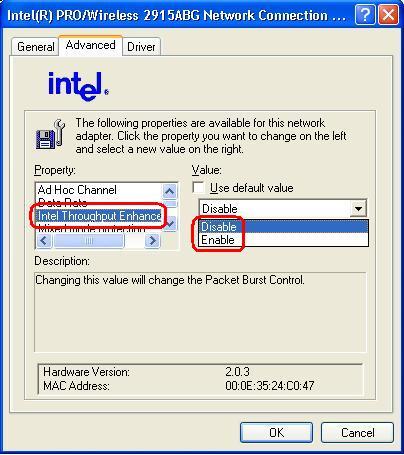Overview
Intel® PROSet/Wireless Software versions 9.0 and later (Windows* XP), and營ntel® Wireless WiFi Link 4965AGN configuration on Windows Vista*, contain an advanced adapter setting for a new feature爇nown as the?em>Intel® Throughput Enhancement.燭his setting爀nables or disables爐he packet burst control for the wireless LAN adapter.燭he default setting is Disable.
Intel Throughput Enhancement?/em>can be enabled in the Advanced tab of the Intel® PRO/Wireless Network Connection properties by燾learing the Use default value checkbox, and changing the Value to Enable. (See figure 1.)

Figure?. Advanced Adapter Settings
You can access the adapter settings from Intel PRO/Set Wireless Software by clicking on the tools menu and then selecting adapter settings. (See figure 2.)

Figure 2.?Adapter Settings Tool
If you do not use Intel PROSet/Wireless Software, you can access the adapter card properties爐hrough the Device Manager accessible through My Computer properties, hardware tab or through the Computer Management Console of the Administrative Tools.?Administrative tools can be accessed either through the regular programs menu or through the Windows Control Panel.
Packet Burst Modes
Two different packet burst modes are supported by the Intel® PRO/Wireless 2915ABG Network Connection.?The first mode supports WMM* †(Wi-Fi Multimedia)燼nd is enabled by negotiation with a WMM capable wireless access point.?WMM is a Wi-Fi Alliance Quality of Service (QoS) enhancement to allow for priority use of bandwidth by audio, video, and voice applications.?WMM support is automatically enabled on the Intel PRO/Wireless燦etwork Connection and is not related to the value set for the Intel Throughput Enhancement. No special configuration is necessary for WMM support.
The second packet burst mode is enabled when the Intel Throughput Enhancement setting of the Intel PRO/Wireless Network Connection is set to Enable.?See figure 1.) The Intel Throughput Enhancement is useful when the client wishes to upload large files, stream audio or video, or share content with others.?This form of packet bursting does not require any support from the wireless access point.?The Intel Throughput Enhancement only increases uplink (client to access point)爌erformance, not download performance.?Therefore, enabling the Intel Throughput Enhancement will not improve performance when downloading files from the Internet or viewing Web pages.
The two packet bursting modes are mutually exclusive.?That is, only one爉ode of packet bursting is enabled at one time.?When the Intel PRO/Wireless 2915ABG Network Connection is associated with a wireless access point where WMM support is negotiated, then the Intel Throughput Enhancement setting will be ignored.?When a WMM association is present,爋nly the WMM feature controls packet bursting.?When a WMM association is not present, then the?em>Intel Throughput Enhancement determines if packet bursting is enabled or disabled.
Frequently Asked Questions
- Why is the feature disabled by default?
When the Intel Throughput Enhancement is enabled, the adapter does not allow for other clients to have equal access to the available wireless bandwidth.
NOTE:?Although bursting by one client does not allow for equal sharing of the wireless medium, the total爐hroughput of the wireless medium will be higher (less idle time) when the Intel Throughput Enhancement is enabled. - When should the feature be enabled?
Consider enabling the Intel Throughput Enhancement setting when operating in an environment where equal access by all clients is not necessary and higher throughput on uploads is desired.?Streaming video, uploading large files, and sharing content are examples of applications that would benefit from using the Intel Throughput Enhancement .?Short duration爋r periodic traffic such as Voice over IP (VoIP) will not see爉uch improvement when using the Intel Throughput Enhancement. - When should the feature be disabled?
The Intel Throughput Enhancement爏etting should be disabled in an environment where equal access by all clients is a priority.?Intel Throughput Enhancement爏hould be disabled in mixed-mode (802.11b and 802.11g)爀nvironments. - How does the feature work?
When the Intel Throughput Enhancement feature is enabled, the wireless adapter may transmit爑sing the Short Interframe Space (SIFS)爄nterval between packets instead of爓aiting for爐he expiration of the Distributed Coordination Function Interframe Space (DIFS) and additional random back-off time.?The shorter wait time results in better爐hroughput of the wireless medium.
† This link will take you off of the Intel Web site. Intel does not control the content of the destination Web Site.
Operating System:
Windows Vista* Starter, 32-bit version, Windows Vista* Home Basic, 32-bit version, Windows Vista* Home Premium, 32-bit version, Windows Vista* Business, 32-bit version, Windows Vista* Enterprise, 32-bit version, Windows Vista* Ultimate, 32-bit version, Windows Vista* Home Basic, 64-bit version, Windows Vista* Home Premium, 64-bit version, Windows Vista* Business, 64-bit version, Windows Vista* Enterprise, 64-bit version, Windows Vista* Ultimate, 64-bit version, Windows* XP 64-Bit Edition, Windows* XP Professional, Windows* XP Home Edition, Windows* XP Tablet PC Edition, Windows* XP Media Center Edition
This applies to:Intel®PRO/Wireless 2200BG Network Connection
Intel®PRO/Wireless 2915ABG Network Connection
Intel®PRO/Wireless 3945ABG Network Connection
Intel®Wireless WiFi Link 4965AGN
It’s going to be finish of mine day, but before ending I am reading this fantastic post to increase my experience.